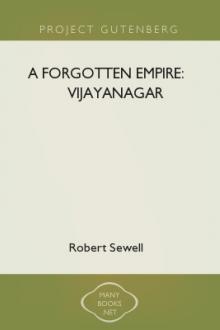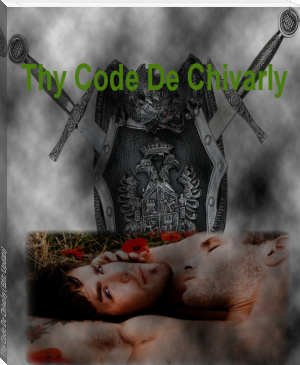A Forgotten Empire: Vijayanagar by Robert Sewell (short story to read TXT) 📕

- Author: Robert Sewell
- Performer: -
Book online «A Forgotten Empire: Vijayanagar by Robert Sewell (short story to read TXT) 📕». Author Robert Sewell
He pitched his camp on the eastern side of that citadel, invested the place, and began a regular siege. After an interval he received intelligence of the arrival of the Adil Shah from Bijapur, on the north side of the Krishna, with an army of 140,000 horse and foot to oppose him.
Having for a few days rested his troops, the Sultan crossed the river, advanced (according to Nuniz) to within nine miles of Raichur, and there entrenched himself, leaving the river about five miles in his rear.[215] Firishtah, however, differs, and says that the Muhammadan forces crossed directly in face of the Hindu army encamped on the opposite bank.
On Saturday morning, May 19, in the year A.D. 1520, according to my deductions, the forces became engaged, and a decisive pitched battle was fought. Krishna Deva, making no attempt to outflank his adversary, ordered an advance to his immediate front of his two forward divisions. Their attack was so far successful that they drove the Muhammadans back to their trenches. The Sultan had apparently deployed his force over too wide an area, expecting that the Raya would do the same; but finding himself weak in the centre he opened fire from the guns that he had previously held in reserve, and by this means caused great loss in the close ranks of the Hindus. The Raya’s troops fell back in face of this formidable bombardment, and at once their enemies charged them. The retreat was changed to a rout, and for a mile and a half to their direct front the Mussulman cavalry chased the flying forces belonging to Krishna Deva’s first line. The king himself, who commanded the second line, began to despair of victory, but rallied his troops, collected about him a number of his nobles, and determined to face death with the bravery that had always characterised him. Mounting his horse, he ordered a forward movement of the whole of his remaining divisions, and charged the now disordered ranks of the Mussulmans. This resulted in complete success, for the enemy, scattered and unable to form, fled before his impetuous onslaught. He drove them the whole way back to, and into, the river, where terrific slaughter took place, and their entire army was put to flight.
The Raya then crossed the river and seized the Shah’s camp, while the Shah himself, by the counsel and help of Asada Khan, a man who afterwards became very famous, escaped only with his life, and fled from the field on an elephant.
While being driven back towards the river, Salabat Khan, the Shah’s general, made a valiant attempt to retrieve the fortunes of the day. He had for his bodyguard 500 Portuguese “renegades,” and with him these men threw themselves into the advancing ranks of the Hindus, where they “did such wonderful deeds” that ever after they were remembered. They penetrated the king’s host, and cut their way forwards till they almost reached his person. Here Salabat Khan lost his horse, but at once mounted another and pressed on. The little force was, however, surrounded and annihilated, and the general, being a second time overthrown, horse and all, was made prisoner.
The spoil was great and the result decisive. For years afterwards the “Moors” cherished a wholesome dread of Krishna Raya and his valiant troops, and the Sultan, panic-stricken, never again during his enemy’s lifetime ventured to attack the dominions of Vijayanagar. Krishna Deva, flushed with victory, returned at once to the attack of Raichur, and the fortress was after a short time captured.
Its fall was due in great measure to the assistance rendered by some Portuguese, headed by Christovao de Figueiredo, who with their arquebusses picked off the defenders from the walls, and thus enabled the besiegers to approach close to the lines of fortification and pull down the stones of which they were formed. Driven to desperation, and their governor being slain, the garrison surrendered.
Date of the Battle.
Now as to the date of this battle.
I am bold enough to believe, and defend my belief, that when Nuniz fixed the day of the great fight as the new moon day of the month of May, A.D. 1522, he made a mistake in the year, and should have written
“1520.”
The chronicler states that Krishna Deva was prepared to give battle on a Friday, but was persuaded by his councillors to postpone his attack till the following day, Friday being unlucky. The battle accordingly took place on the Saturday, which was the new moon day.
Before proceeding to examine the month and day, let us consider the year A.D. of the battle.
Paes describes two grand festivals at the capital of which he was an eye-witness, and at which Christovao de Figueiredo was present. He fixes definitely the days on which these occurred. The first was the nine-days MAHANAVAMI festival, and the second was the festival of the New Year’s Day. Paes states that on the occasion when he was present the MAHANAVAMI began on September 12 (“ESTAS FESTAS SE COMECAO A DOSE D�AS DE SETEBRO E DURAO NOVE DIAS”[216]), and the latter began on October 12 (“ENTRAMDO O MES D OUTUBRO A OMZE DIAS AMDADOS D ELE ... NESTE DIU COMECAO O ANNO, E DIA D ANNO BOM ... COMECAO O ANNO NESTE MES COM A LUA NOVA, E ELLES NAO CONTAO O MES SE NAO DE LUA A LUA”).[217] Previously to this, when writing about Raichur, Paes has described that place218 as a city “that formerly belonged to the king of Narsymga (I.E. Vijayanagar); there has been much war over it, and THIS KING took it from the Ydallcao” (Adil Shah). The chronicler, therefore, was present at these feasts on an occasion subsequent to the date of Krishna Deva’s conquest of Raichur.
Now the MAHANAVAMI festival begins in these tracts on the 1st of the month of Asvina, and the New Year’s Day in the time of Paes was evidently celebrated on the 1st of the month Karttika, as was often the case in former years both days being the days following the moment of new moon. In what year, then, during the reign of Krishna Deva Raya, did the 1st of Asvina and the 1st of Karttika fall respectively on September 12 and on October 12? I have worked these dates out for all the years of the reign, and I find that in no year except A.D. 1520 did this occur. In 1521 the MAHANAVAMI fell on September 2, and the New Year’s Day on October 1; in 1522 the former fell on September 20, and the latter on October 20. This shows that Paes assisted at the festivals of A.D. 1520, and that therefore the battle and capture of Raichur must have taken place before the month of September in that year.
This again throws fresh light on the magnificent reception accorded to Christovao de Figueiredo by the king, and the latter’s exceptional kindness to the Portuguese at the time of these feasts.[219] Krishna Raya cherished an especial fondness for Christovao on account of his invaluable aid at the siege of the city, and for the fact that but for him the war might have lasted much longer.
Let us now turn to the other Portuguese writers, and see whether they confirm our date, 1520, for the fall of Raichur.
The decision of this question turns mainly on the date when the Portuguese obtained the mainlands opposite the island of Goa, consisting of the tracts called Salsette, Ponda, and Bardes. It seems certain that this capture of the mainlands took place by Krishna Deva’s connivance shortly after the fall of Raichur, at a time when Diogo Lopes de Sequeira, the governor-general, was away at the Red Sea, and when Ruy de Mello was governor of Goa. Now Sequeira left Goa for the Red Sea on February 13, A.D. 1520, and arrived again before Diu in India on February 9, 1521.
Castanheda tells us (and he is a good authority, since he was in India in 1529) that while Sequeira was absent at the Red Sea war broke out between the king of Vijayanagar and the Adil Shah,[220] at the close of which the latter was defeated and put to flight, while the Hindus took Raichur and other places
“so that many of the TANADARIS221 near Goa on the mainland were left undefended. And since the king of Narsinga was very rich, and had no need of these lands, and wanted that all the horses that came to Goa should come to him and none to the HIDALCAO, he sent to say to Ruy de Mello, captain of Goa, that he had taken Belgaum by force of arms from the Hidalcao, with all the land appertaining to it as far as the sea, in which were TANADARIS yielding more than 500,000 gold pardaos, of which he desired to make a present to the king of Portugal … and that he wanted all the horses that came to Goa. He therefore said that the captain of Goa could enter and take possession of the TANADARIS.”
This was immediately done, and Ruy de Mello took possession of the mainland of Goa, including Salsette, in ten days.
Correa, who was in India at the time, having gone thither in 1512 or 1514, mentions222 that de Sequeira left Goa for the Red Sea in January 1520, and that “at that time” (NESTE TEMPO — the expression is unfortunately vague) war broke out between Vijayanagar and Bijapur. After its close the Hindu king sent a message to “Ruy de Mello, captain of Goa,” in the absence of the governor-general, regarding the mainlands of Goa. Correa does not mention distinctly the year in which this occurred, but the edition of 1860 at the head of the page has the date “1521.” This, however, must be an error on the part of the editor, for in May 1521 Sequeira was not absent, and therefore the year referred to cannot be 1521; while in May 1522 Dom Duarte de Menezes, and not Sequeira, was governor-general.[223] Sequeira sailed for Portugal January 22, A.D. 1522.
Barros relates the departure of de Sequeira from India for the Red Sea on February 13, 1520, and states that in his absence Ruy de Mello was governor of Goa, under Sequeira’s lieutenant, Aleixo de Menezes. Ruy de Mello seized the mainland of Goa after the battle of Raichur,[224] and at that time de Sequeira was absent at the Red Sea. His description of the siege of Raichur and the great battle in the vicinity clearly seems to have been taken from the chronicle of Nuniz. It follows the latter blindly, even in the misspelling of names, and therefore is really of no greater value. When, however, Barros comes to deal with the acquisition of the mainlands of Goa,[225] he is dependent on other information, and gives a much more detailed account. The time is clearly fixed. After the battle and flight of the Adil Shah the feeling between the two adversaries was naturally highly strained, and this “enabled Ruy de Mello, captain of Goa, to take the mainlands of Goa.” Sequeira was at the Red Sea and Menezes at Cochin. A very important passage for my present purpose occurs





Comments (0)